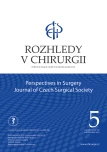Robotic pulmonary segmentectomy, initial experience in the Czech Republic
Authors:
J. Kolařík 1; J. Tavandžis 1; R. Novysedlák 1; J. Vachtenheim 1; D. Sibřina 2,3; M. Švorcová 1; J. Pozniak 1; J. Šimonek 1; J. Schützner 1; R. Lischke 1
Authors‘ workplace:
III. chirurgická klinika 1. lékařské fakulty Univerzity Karlovy a Fakultní nemocnice v Motole, Praha, Česká republika
1; Durham University, United Kingdom
2; Institut klinické a experimentální medicíny, Praha, Česká republika
3
Published in:
Rozhl. Chir., 2023, roč. 102, č. 5, s. 199-203.
Category:
Original articles
doi:
https://doi.org/10.33699/PIS.2023.102.5.199–203
Overview
Introduction: The initiation of lung cancer screening in Czechia and diagnosis in earlier stages has been reflected by an increasing demand for anatomical lung segmentectomy. The purpose of this study was to describe early results of the first robotic-assisted thoracoscopic segmentectomies performed in the country.
Methods: Our institution has performed 151 robotic anatomical lung resections since the initiation of the screening program in August 2020, which enabled us to attain the status of a proctoring and case observation centre. The robotic segmentectomy program was initiated after completing 70 robotic lobectomies. We performed a retrospective analysis of the results of our first 20 patients indicated for robotic segmentectomy.
Results: Median age of the patients was 60, with 11 females and 7 males. The most common indications included primary lung malignancy (n=13), pulmonary metastasis (n=2) and benign lesions (n=3). We performed 11 simple segmentectomies, 6 complex (S2, S3, S1a+2, S10 on the right) and one right S6 segmentectomy with bronchoplasty. The mean number of harvested lymph nodes for NSCLC was 20, the mean blood loss was 25 mL (from 10 mL to 100 mL), and the mean operative time was 200 minutes. All resection margins were tumour-free. There was no conversion to thoracotomy. Two patients were excluded as they required conversion to robotic lobectomy given that their lesions were localized close to the intersegmental plane. One complication (recurrent laryngeal nerve paralysis) occurred in 1 patient. Mean chest tube duration was 1.9 days and length of stay 3.9 days.
Conclusion: Our experience suggests that implementation of the robotic segmentectomy program after completion of the robotic learning curve provides promising outcomes. Robotic technology and preoperative planning facilitate this technically demanding procedure especially when bronchoplasty is required.
Keywords:
lung cancer – learning curve – lymphadenectomy – robotic lung segmentectomy – bronchoplasty – mediastinal
Sources
1. Lambert L, Janouskova L, Novak M, et al. Early detection of lung cancer in Czech high-risk asymptomatic individuals (ELEGANCE): A study protocol. Medicine (Baltimore) 2021 Feb 5;100(5):e23878. doi:10.1097/MD.0000000000023878. PMID: 33592843; PMCID: PMC7870244.
2. Subramanian MP, Liu J, Chapman WC Jr, et al. Utilization trends, outcomes, and cost in minimally invasive lobectomy. Ann Thorac Surg. 2019 Dec;108(6):1648–1655. doi:10.1016/j.athoracsur.2019.06.049. Epub 2019 Aug 7. PMID: 31400324; PMCID: PMC6878158.
3. Baste JM, Soldea V, Lachkar S, et al. Development of a precision multimodal surgical navigation system for lung robotic segmentectomy. J Thorac Dis. 2018 Apr;10(Suppl 10):S1195– S1204. doi:10.21037/jtd.2018.01.32. PMID: 29785294; PMCID: PMC5949399.
4. Ginsberg RJ, Rubinstein LV. Randomized trial of lobectomy versus limited resection for T1 N0 non-small cell lung cancer. Lung Cancer Study Group. Ann Thorac Surg. 1995 Sep;60(3):615–622; discussion 622–623. doi:10.1016/0003-4975(95)00537-u. PMID: 7677489.
5. Altorki N, Wang X, Kozono D, et al. Lobar or sublobar resection for peripheral stage IA non-small-cell lung cancer. N Engl J Med. 2023 Feb 9;388(6):489–498. doi:10.1056/NEJMoa2212083. PMID: 36780674.
6. Saji H, Okada M, Tsuboi M, et al. West Japan Oncology Group and Japan Clinical Oncology Group. Segmentectomy versus lobectomy in small-sized peripheral non-small-cell lung cancer (JCOG0802/WJOG4607L): a multicentre, open-label, phase 3, randomised, controlled, non-inferiority trial. Lancet. 2022 Apr 23;399(10335):1607–1617. doi:10.1016/S0140-6736(21)02333-3. PMID: 35461558.
7. Brunelli A, Decaluwe H, Gossot D, et al. Perioperative outcomes of segmentectomies versus lobectomies in high-risk patients: an ESTS database analysis. Eur J Cardiothorac Surg. 2020 Sep 15:ezaa308. doi:10.1093/ejcts/ezaa308. Epub ahead of print. PMID: 32929479.
8. Tane S, Nishio W, Fujibayashi Y, et al. Thoracoscopic left S1 + 2 segmentectomy as a good resolution for preserving pulmonary function. Interact Cardiovasc Thorac Surg. 2020 Sep 1;31(3):331–338. doi:10.1093/icvts/ivaa105. PMID: 32747959.
9. Handa Y, Tsutani Y, Mimae T, et al. Oncologic outcomes of complex segmentectomy: A multicenter propensity scorematched analysis. Ann Thorac Surg. 2021 Mar;111(3):1044–1051. doi:10.1016/j.athoracsur. 2020.06.020. Epub 2020 Aug 12. PMID: 32795524.
10. Lee DS, LaChapelle C, Taioli E, et al. Second primary lung cancers demonstrate similar survival with wedge resection and lobectomy. Ann Thorac Surg. 2019 Dec;108(6):1724–1728. doi:10.1016/j.athoracsur.2019.06.023. Epub 2019 Jul 31. PMID: 31376378.
Labels
Surgery Orthopaedics Trauma surgeryArticle was published in
Perspectives in Surgery

2023 Issue 5
- Metamizole vs. Tramadol in Postoperative Analgesia
- Metamizole at a Glance and in Practice – Effective Non-Opioid Analgesic for All Ages
- Possibilities of Using Metamizole in the Treatment of Acute Primary Headaches
Most read in this issue
- Massive transfusion protocol
- Pneumatosis cystoides intestinalis as a rare cause of non-surgical pneumoperitoneum
- Peroral endoscopic myotomy (POEM) in the treatment of severe postfundoplication dysphagia
- Robotic pulmonary segmentectomy, initial experience in the Czech Republic
